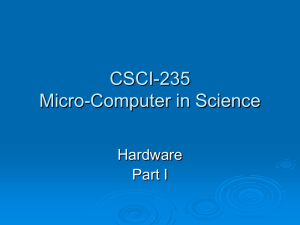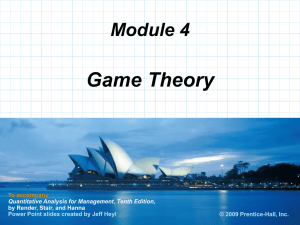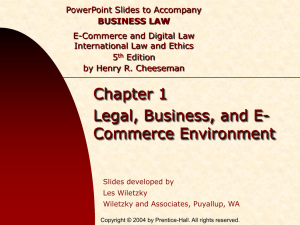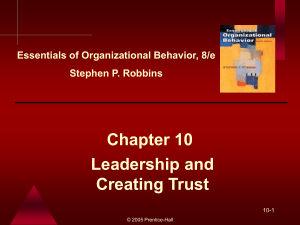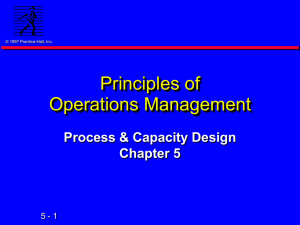ppt
advertisement
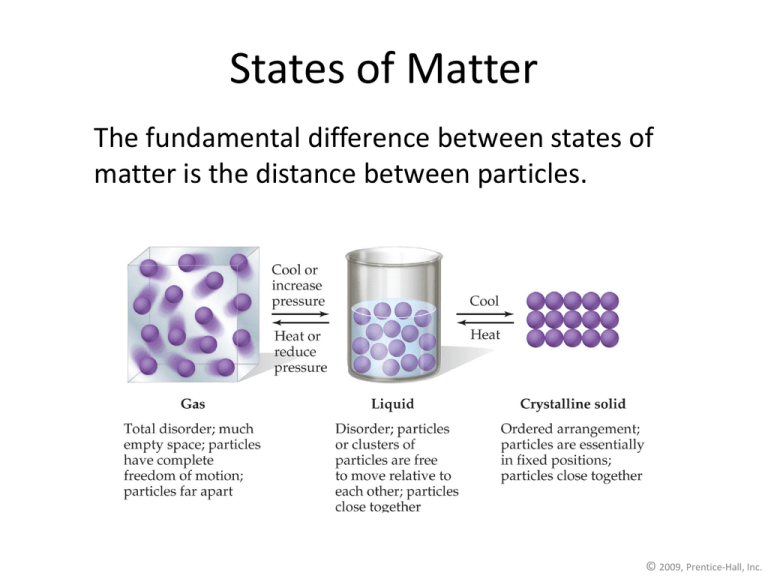
States of Matter The fundamental difference between states of matter is the distance between particles. © 2009, Prentice-Hall, Inc. The States of Matter • The state a substance is in at a particular temperature and pressure depends on two antagonistic entities: – the kinetic energy of the particles; – the strength of the attractions between the particles. © 2009, Prentice-Hall, Inc. Intra- and Inter- molecular Forces Section 14.1 Let’s start with Intra-molecular attractions • What are these? – The prefix intra means within, so these attractions are the ones within a molecule, otherwise known as… BONDS • We are familiar with two – Ionic (when one atom gives up an electron, the other one takes it, then they are attracted due to opposite charges) – Covalent (when two atoms share two electrons) This brings us to INTER-molecular attractions • What does this term mean? • The prefix INTER means between (like interstate highway – a highway that goes between states) • IMF’s then are forces that exist between molecules. IMF Intermolecular Forces The attractions between molecules are not nearly as strong as the intramolecular attractions that hold compounds together. © 2009, Prentice-Hall, Inc. Intermolecular Forces They are, however, strong enough to control physical properties such as boiling and melting points, vapor pressures, and viscosities. © 2009, Prentice-Hall, Inc. Intermolecular Forces These intermolecular forces as a group are referred to as van der Waals forces. © 2009, Prentice-Hall, Inc. van der Waals Forces • Dipole-dipole interactions • Hydrogen bonding • London dispersion forces © 2009, Prentice-Hall, Inc. Dipole-Dipole Interactions • Molecules that have permanent dipoles are attracted to each other. – The positive end of one is attracted to the negative end of the other and viceversa. – These forces are only important when the molecules are close to each other. © 2009, Prentice-Hall, Inc. Dipole-Dipole Interactions The more polar the molecule, the higher is its boiling point. © 2009, Prentice-Hall, Inc. London Dispersion Forces While the electrons in the 1s orbital of helium would repel each other (and, therefore, tend to stay far away from each other), it does happen that they occasionally wind up on the same side of the atom. © 2009, Prentice-Hall, Inc. London Dispersion Forces At that instant, then, the helium atom is polar, with an excess of electrons on the left side and a shortage on the right side. © 2009, Prentice-Hall, Inc. London Dispersion Forces Another helium nearby, then, would have a dipole induced in it, as the electrons on the left side of helium atom 2 repel the electrons in the cloud on helium atom 1. © 2009, Prentice-Hall, Inc. Hydrogen Bonding • The dipole-dipole interactions experienced when H is bonded to N, O, or F are unusually strong. • We call these interactions hydrogen bonds. © 2009, Prentice-Hall, Inc. Hydrogen Bonding • Hydrogen bonding arises in part from the high electronegativity of nitrogen, oxygen, and fluorine. Also, when hydrogen is bonded to one of those very electronegative elements, the hydrogen nucleus is exposed. © 2009, Prentice-Hall, Inc. Summarizing Intermolecular Forces © 2009, Prentice-Hall, Inc. Intermolecular Forces Affect Many Physical Properties The strength of the attractions between particles can greatly affect the properties of a substance or solution. © 2009, Prentice-Hall, Inc. Viscosity • Resistance of a liquid to flow is called viscosity. • It is related to the ease with which molecules can move past each other. • Viscosity increases with stronger intermolecular forces and decreases with higher temperature. © 2009, Prentice-Hall, Inc. Surface Tension Surface tension results from the net inward force experienced by the molecules on the surface of a liquid. © 2009, Prentice-Hall, Inc. Vapor Pressure • At any temperature some molecules in a liquid have enough energy to escape. • As the temperature rises, the fraction of molecules that have enough energy to escape increases. © 2009, Prentice-Hall, Inc. Vapor Pressure As more molecules escape the liquid, the pressure they exert increases. © 2009, Prentice-Hall, Inc. Vapor Pressure The liquid and vapor reach a state of dynamic equilibrium: liquid molecules evaporate and vapor molecules condense at the same rate. © 2009, Prentice-Hall, Inc. Vapor Pressure • The boiling point of a liquid is the temperature at which it’s vapor pressure equals atmospheric pressure. • The normal boiling point is the temperature at which its vapor pressure is 760 torr. © 2009, Prentice-Hall, Inc. Phase Diagrams Phase diagrams display the state of a substance at various pressures and temperatures and the places where equilibria exist between phases. © 2009, Prentice-Hall, Inc. Phase Diagram of Water • Note the high critical temperature and critical pressure. – These are due to the strong van der Waals forces between water molecules. © 2009, Prentice-Hall, Inc. Phase Diagram of Carbon Dioxide Carbon dioxide cannot exist in the liquid state at pressures below 5.11 atm; CO2 sublimes at normal pressures. © 2009, Prentice-Hall, Inc. How are inter- and intra- molecular attractions related? • INTER-molecular attractions depend on the type of INTRA-molecular attraction inside the molecule. • Determining both of these will help explain the differences in MP’s and BP’s of different substances. Heating Curve



